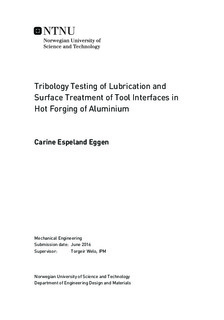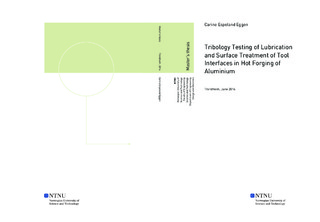| dc.description.abstract | This thesis investigated the lubrication conditions in hot forging of aluminium. The most common lubricants to apply in hot forging of aluminium are oil-based and water-based, both containing graphite. Oil-based graphite lubricants give certain health and safety challenges and are not environmental-friendly. Water-based graphite lubricants tend to not give optimal lubrication at high temperatures. Therefore alternative lubricants were discussed and tested in this thesis. The possibility of coating the tools was also investigated as this process can improve the mechanical properties of the tools.
A literature study and the commercial availability of the coatings and lubricants were used to select which coatings and lubricants to test. The combination of recommended lubricants and coatings were tested in a TE 88 multi-station friction and wear test machine, with a reciprocating pin on plate configuration. The pin represented the forging tool and was made of steel. The plate was made of aluminium and represented the workpiece.
The coatings that were selected to test were an aluminium chromium nitride coating, and an aluminium titanium nitride coating, which were applied to the pins. Uncoated pins were also tested to represent the tool steel Raufoss Technology uses today. Some pins were polished without applying a coating. Two new types of lubricant were tested, in addition to the current water-based graphite lubricant, Lubrodal F 33 Al, used by Raufoss Technology today. The new types of lubricants were produced by Klüber lubrication. Wolfraco WF 51 W is a water-based graphite free lubricant, and Klüberplus S 08-107 is a solid graphite lubricant.
The friction coefficient was lower at the tests with the coated and polished pins compared to the untreated pins. There was no significant difference between the performances of the surface treatments, the surface roughness had a much larger impact. No aluminium transfer was found at any of tests when the lubricant worked well.
The lowest friction coefficient was with an AlTiN coated pin tested together with Lubrodal F 33 Al. There was some trouble with the water-based lubricants not sticking to the hot surface at temperatures above 200 C. Klüberplus S08-107, which is a solid lubricant, worked well also at 300 C. The tests done with Klüberplus S08-107 had the highest coefficient of friction but it was significantly reduced after the pin was coated.
Klüberplus S08-107 is applied to the workpiece before it enters the forging press, so the forging time will be reduced. This enables the machine to produce more parts, and the costs per part will be reduced. Klüberplus S08-107 combined with coating or polishing of the tools was recommended as the best combination for further testing. | |

